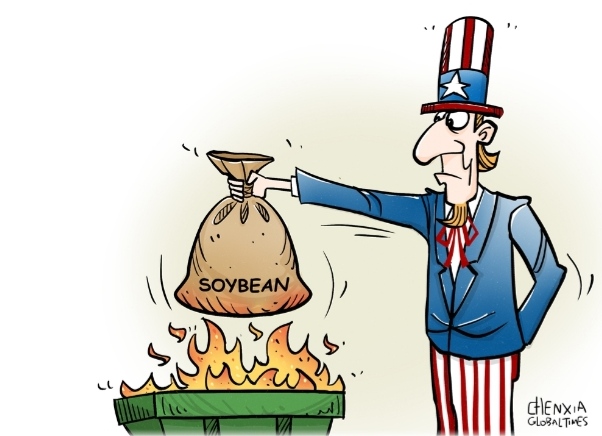US politicians’ arrogance will harm soybean farmers eyeing Chinese market

By Hu Weijia
It should come as no surprise that Reuters reported on Sunday that China’s soybean imports from the US fell 62.3 percent in July from a year earlier. Whether China buys US soybeans or not is determined by economic factors. If US soybeans are not economically competitive, relying solely on exerting economic coercion cannot support US soybean exports.
China is the world’s largest soybean importer, accounting for nearly 60 percent of global trade and half of US soybean export value, according to data from the US Department of Agriculture. China’s market is crucial for US soybean exports. However, it is regrettable to see politicians in Washington unwilling to cherish the economic complementarity between the two countries.
Over the past few years, the US has launched an overall campaign of suppression against China, and is trying to rope in other Western countries to form an anti-China alliance. Amid Washington’s “decoupling” or “de-risking” calls, will US soybeans lose the Chinese market?
It should be noted China does not suppress US soybeans for geopolitical reasons, but politicians in Washington better wake up from their daydreams, in which they believe economic coercion can be used to open the doors of the Chinese market and give American goods an unreasonable competitive advantage.
In China, a bumper harvest can be expected for 2023, despite the multiple challenges of natural disasters and volatile global commodity prices. The country’s summer grain output totaled 146.13 million metric tons this year. Its summer grain sown area has grown for three consecutive years, rising to 26.61 million hectares in 2023.
China made great efforts to adjust its agricultural structure and strenuously expand the farming scale of soybeans and oilseeds. A mix of methods, including crop rotation and intercropping, has been used to expand the growing area for soybean and rapeseed. In 2022, soybean output rose to 20.28 million metric tons, 3.89 million higher than a year earlier.
It was the first time the soybean output on the Chinese mainland surpassed 20 million tons, helping raise the soybean self-sufficiency rate by 3 percentage points in a single year, to 18.5 percent, according to official data.
This does not mean China will close its doors to soybean imports. However, Chinese officials have repeatedly stated that the country will diversify its soybean imports and strengthen cooperation with various countries.
Lu Jingbo, deputy head of the National Food and Strategic Reserves Administration, said at a press briefing in May that the authorities will promote diversification of soybean imports by exploring more sources.
It is estimated that the soybean output worldwide will hit a record high in 2023. According to the US Department of Agriculture, global soybean production is forecast to reach a record 410.6 million metric tons, up 40.2 million metric tons from 2022/23 on an increase in planted area and a trend yield.
This development has added to evidence that we are not in a seller’s market anymore, which means China, as the world’s largest soybean buyer, will gain more say and decision-making power in the global market. It’s up to China to decide where it imports from and how much it imports. In order to win the Chinese market, US soybeans must prove their economic competitiveness.
However, US politicians seem to lack respect for China’s market. Their arrogance and paranoia are harming American farmers. The US has been waging an economic “decoupling” from China, in which national security concerns have replaced economic logic. The losses of American farmers should sound an alarm for Washington. The US goal of forced “decoupling” from China will fail in a globalized marketplace.



